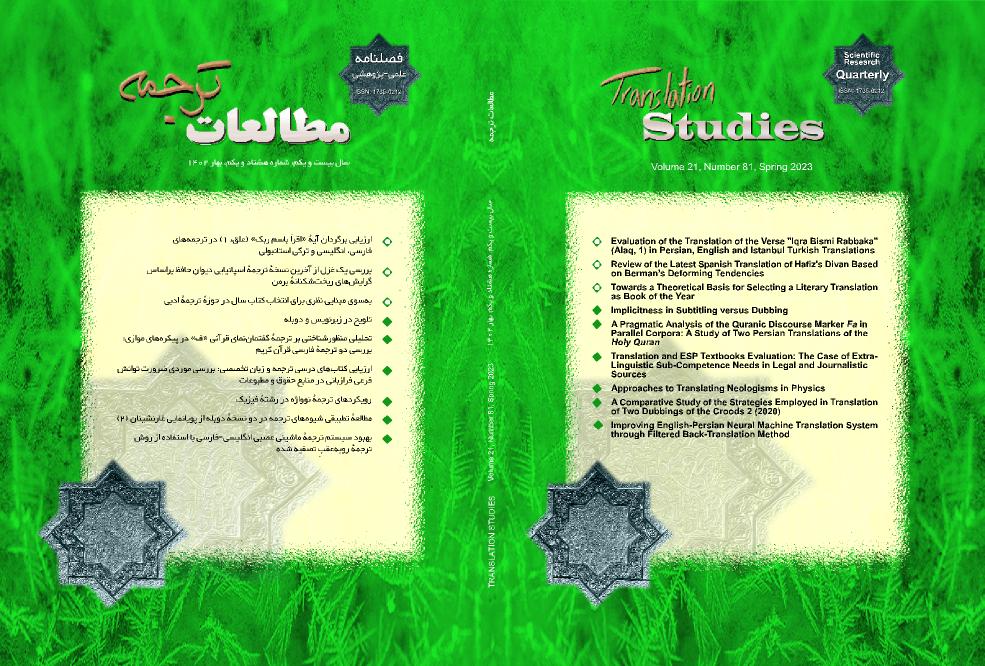The Implicitness in Dubbing versus Subtitling
Abstract
The purpose of the Present study was to determine the difference between translations of English feature films and their Persian dubbed and subtitled versions in terms of implicitness. To this aim, i.e., to find the degree of implicitness the researcher conducted the research in the light of Larson's (1984) concept of implicit information/meaning. The material gathered for this purpose consisted of five movies in two versions, one dubbed and the other subtitled version. The research investigated hundred minutes of the movies (twenty minutes from each movie) containing a total of 1600 frames of which 163 frames contained implicit meaning/information in either of the two versions. In order to have a contrastive analysis of the two versions, the two translations were listed in tables to be compared and contrasted so as to track down instances of implicit meaning. Afterwards, the researcher got a percentage at the frequency of referential, situational and organizational implicit meanings in the two versions. According to the statistical analysis 80.37 percent of the implicit meanings in the five films belonged to the subtitled versions and 19.63 percent of the implicit meanings belonged to the dubbed versions. Thus, the findings testified that subtitled versions are more implicit than their corresponding dubbed versions. Meanwhile, implicit situational meaning had the highest frequency and implicit organizational meaning the least.
Keywords: Audiovisual Translation, Dubbing, Implicitness, Implicit Organizational Meaning, Implicit Referential Meaning, Implicit Situational Meaning, Subtitling
References
Baker, Mona (ed.) (2001). Routledge encyclopedia of translation studies. London and New York: Routledge.
Barnwell, Katharine (1980). Introduction to semantics and translation. Horsleys Green, England: Summer Institute of Linguistics.
Baumgarten, N. (2005). The Secret Agent: Film Dubbing and the Influence of the English Language on German Communicative Preferences. Towards a Model for the Analysis of Language Use in Visual Media, [Ph.D. Thesis], University of Hamburg.
Bogucki, Lukasz (2004). ‘The Constraint of Relevance in subtitling’. The Journal of Specialised Translation. Issue 01. Retrieved November 24, 2009, Available from http://www.jostrans.org/issue01/art_bogucki_en.php
Diaz-Cintas, J. (2004). ‘Subtitling: The long journey to academic acknowledgement.’ The Journal of Specialised Translation. Issue 01. Retrieved November 24, 2009, from http://www.jostrans.org/issue01/art_Diaz_Cintas.php
Englund-Dimitrova, B. (2005). Expertise and explicitation in the translation process. Amsterdam/Philadelphia: John Benjamins.
Hajebi, S. and Samir, A. (2022). ‘Exploring Differences in Persian Dubbed and Subtitled Versions of the Songs in Animated Musical Movies’. Journal of Research in Techno-based Language Education, Vol. 2, No. 1, Tabaran Institute of Higher Education.
Kelly-Holmes, H. (1999). European television discourse in transition. Clevedon: Multilingual Matters.
Larson, Mildred, L. (1984). Meaning-based translation: A guide to cross-Language equivalence. Lanham/New York/London: University Press of America.
Orero, P. (ed.) (2004). Topics in audiovisual translation. Amsterdam: John Benjamins.
Ziya Hoseyni, Mohammad (1999). A contrastive analysis of Persian & English & error analysis. Tehran: Nashr-e Vira.
Downloads
Published
How to Cite
Issue
Section
DOR
License
Copyright (c) 2023 Mehdi Bagheri Hariri, Reza Abbasi

This work is licensed under a Creative Commons Attribution-NonCommercial 4.0 International License.
Copyright Licensee: Iranian Journal of Translation Studies. This article is an open access article distributed under the terms and conditions of the Creative Commons Attribution–NonCommercial 4.0 International (CC BY-NC 4.0 license).





